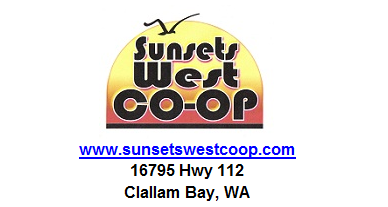Strait of Juan de Fuca
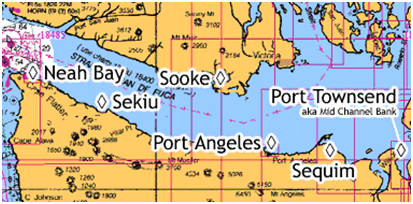
Fishing the Strait of Juan de Fuca can be lots of fun. While the weather can be windier and rougher than Puget Sound, it’s usually not nearly as bad as off the coast.
When you fish the Straits, you get a shot at many more fish than you do in Puget Sound, because lots of fish dip into the Straits from the ocean, as well as there are a number of fish in the Straits that are bound for Canadian waters. Select a region to learn more:
Neah Bay
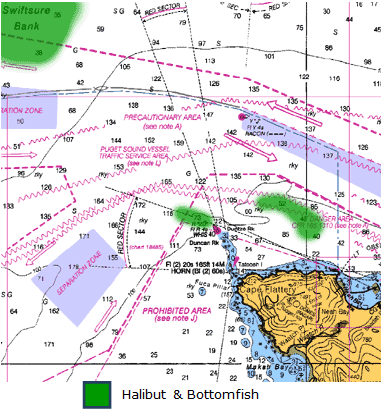
Neah Bay Halibut
Neah Bay is the state’s best-known and top-producing area for halibut and where the Washington state record 288-pound flatfish was caught.
Ocean halibut fishing is a fun and rewarding challenge. Great memories can be made along with a chance of harvesting some of the best eating fish in the world!

Fishing the inside waters of Area 4B: One of the most popular is the Garbage Dump located just to the west of Neah Bay. This area is close to shore and very popular, as it tends to be less lumpy. You can normally see the dump burning up on the hill making it easy to find fish the 300-325 ft. water. You can back into the current with your motor to slow your drift and give your bait more bottom time.
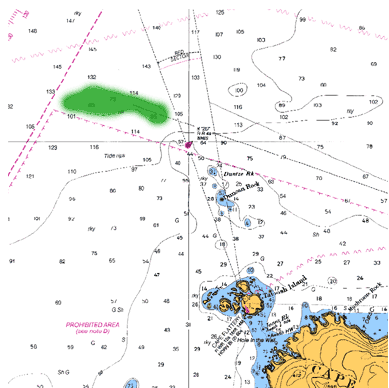
The next inside spot that has accounted for many halibut is the area just west of Duncan Rock. About halfway between the Canadian boundary line and Duncan Rock the bottom comes up to about 300 ft. You will need to work the tide and wind and hang tough but you can land some nice halibut here if you put in your time. Offshore Locations: The blue water is where most of the halibut action takes place. The most fished areas are Swiftsure, 72 square, and the US or Canadian Blue Dot along with many other locations that reside on secret GPS logs. Swiftsure is the shorter run about 10-14 miles west of Cape Flattery. This is big water and there are NO landmarks out here. You will need a good GPS unit to find these locations. You should also have a VHF radio so if you have a problem you can call the Coast Guard and it will allow you to monitor the weather, which can change quickly on the ocean. If it’s your first trip here take a charter it’s the quick way to see how things work.
Tides: Tides are the key factor when planning a trip to Neah Bay. The less water movement the better the fishing will be, not that you can’t catch halibut on a bigger tide change, it’s just a shorter window and you have to use a lot more lead to stay in contact with the bottom. I look for a day with slow current change; normally the fishing will be good all day. Spreader Bars with large horse herring (purple or black label) are the standard bait for flaties. I rig them with a 20 inches of 50-lb. mono shock leader from a ball bearing swivel to the spreader bar coming from the Tuff Line XP. Hook up the herring whole so it will spin on the leader from the spreader bar. Add enough weight to stay in contact with the bottom and you’re ready to hunt big flat fish. You can also try a little octopus tentacle as it makes great bait when the herring supply runs low. If you have an encounter with a swarm of dogfish it’s time to pull out the artificial jigs. Large jigs with scampi tails can really save the day when the dogs move in.
Dealing with big Halibut: These fish are big and powerful, you don’t want to drag a big halibut onboard your boat without subduing it first… it can do serious damage to your boat not to mention your body! For a real large halibut I start by harpooning it with the line from the detachable head on the harpoon hooked up about 20 ft. down the line to a large Scotsman float. Leave about 30 feet of line after the float then attach that to the boat cleat. After harpooning let the Halibut wear itself out pulling on the float. I then club it a few times, drag it in the boat and hog tie the tail to the head through the gills on the fish. Use gloves, the teeth are sharp. Now the halibut is safe and ready for transport. Then cut the gills and let the fish bleed out. This will also make for a better eating fish.
Limits: Always check the WDFW Regulations for seasons and limits. If you acquire a Canadian license before arriving at Neah Bay you can fish the Canadian side also.
Anglers heading up after May 25th can score the early king salmon opener followed shortly by the summer Coho run.
Port Angeles
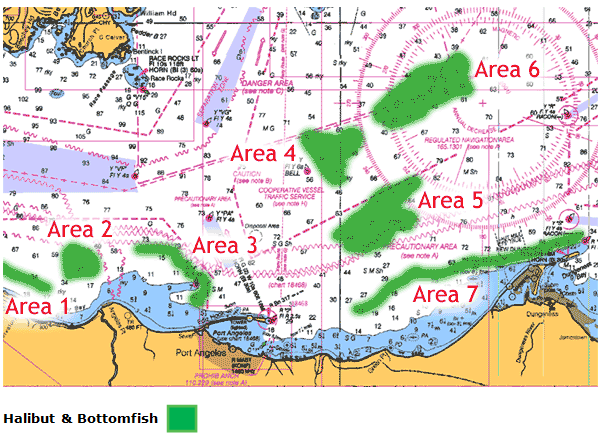
Port Angeles is located at the perfect spot on the Strait of Juan De Fuca to intercept all the salmon runs returning to central and south Puget Sound. Port Angeles is also the launching point for the best halibut fishing in the eastern strait. A short boat ride takes you to legendary halibut banks and shoals such as Freshwater Bay, the Humps, 31-36 Bank, the Rock Pile, Coyote Bank, Green Point and many others. All places that consistantly hold salmon, but really come into their own during halibut season.
The halibut that inhabit the murky depths of Port Angeles are not as plentiful as Neah Bay, but are usually larger in size. The average halibut usually weigh in the 50 pound range, with several caught each year over 100 pounds and the occasional 200+ pounder.
Another plus for Port Angeles is the location of the town itself. Located on the edge of the Straits of Juan De Fuca, and the Olympic Mountains, this area offers spectacular scenery, miles of nearby beaches and hiking ranging from the alpine meadows of Hurricane Ridge to lowland river trails. This is a perfect place for your family (who arent fisherfolk) to entertain themselves while you are out on the water. The anglers in your family will find tackle shops, marine supply stores, launch ramps and moorage readily available.
Accommodations in Port Angeles range from upscale hotels (with moderate pricing) such as the Red Lion to quiet B & Bs and nearby campgrounds and R.V. Parks.
Port Angeles Launch Ramps
Port Angeles Ramp: located on Ediz Hook. This is a good ramp with moderate grade. The east lane of the ramp needs repair. The west lane is in good shape. This ramp is protected from weather and has ample parking.
Boat Haven: located in the west sector of Port Angeles. There are actually two very good ramps, referred to as east and west ramps. A good grade and protected water. Both ramps share parking. During summer there is a conflict with customers of Boat Haven over use of parking. Moorage and business customers have a priority. Transit moorage is available at Boat Haven (360) 457-4505.
Freshwater Bay: a shallow ramp needing +5ft. tide to launch. No launch or retrieval available at low tides. Not a good spot to launch a large boat.
There is ample parking, however there is no dock.
Port Angeles Halibut Fishing Areas
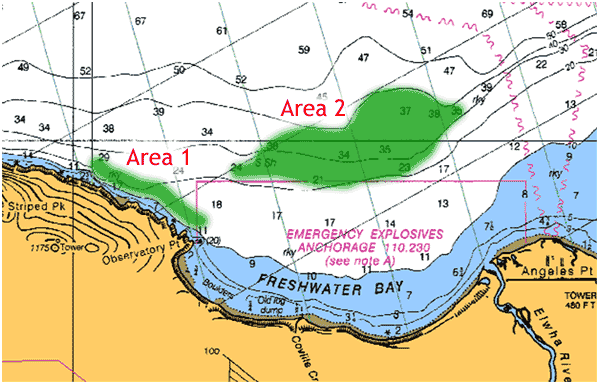
Area 1: Observatory Point Troll or mooch along 120 ft. to 200 ft. ledge for halibut. You will find lingcod in the rocky areas.
Location: N48°09′ x W123°38′.
Area 2: Freshwater Bay sand flat holding halibut in the 120 to 240 ft depths. This is an area that seems to have fewer dogfish.
Location: N48°10′ x W123°35′.
Area 3: The Humps located 4 miles west of Ediz Hook and sometimes referred to as the 3 Humps or 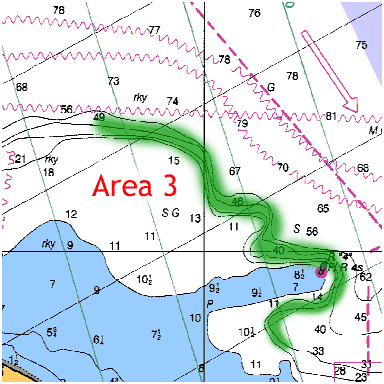 1st Hump, 2nd Hump, 3rd Hump. Fair trolling for Halibut in 100 ft to 200 ft depths. Rocky in certain areas, so watch your downrigger depths. Moochers do best on the incoming tide. Drift parallel to the shelf or south of the first hump in 90 to 300 ft of water.
1st Hump, 2nd Hump, 3rd Hump. Fair trolling for Halibut in 100 ft to 200 ft depths. Rocky in certain areas, so watch your downrigger depths. Moochers do best on the incoming tide. Drift parallel to the shelf or south of the first hump in 90 to 300 ft of water.
Location: N48°10′ x W123°29′.
Area 4: The Rock Pile located 7 1/2 statute miles north of Ediz Hook. One of the premier spots for mooching or jigging for Halibut. Not a place to troll. Can be crowded, so use your kicker motor to hold against the tide. Keep your lines as straight down as possible. Drift from 100 ft depth out to 300 ft depth on the down side of the tidal flow. In other words, west side of the Rockpile on the ebb tide, east side on the flood tide.
Location: N48°14′ x W123°20′.
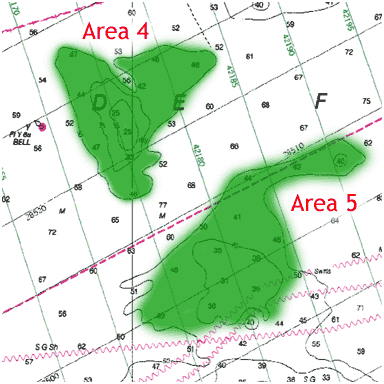
Area 5: 31-36 Hole located 6 miles northwest of Ediz Hook. This bank is very heavily fished, but only because it is a consistent producer of Halibut. 31-36 Hole is a large bank with room for both drift fishermen and trollers. Drift fishermen should start on top of the bank in 180 ft of water and drift off until they can no longer stay on the bottom. Drifters should use their boat motors to hold against the tidal flow. Trollers should work the large sand flat on the northeast side. This is a deep slow troll in the 240 to 300 ft depths.
Location: N48°12′ x W123°18′.
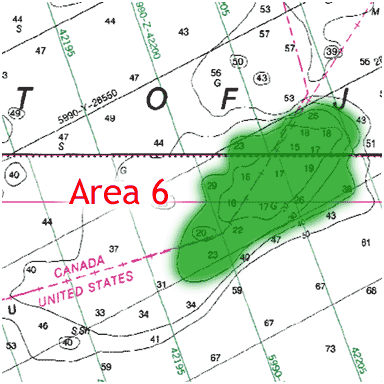
Area 6: Coyote Bank located 13 statute miles from Ediz Hook. The Canadian border intersects Coyote Bank. If you dont have a Canadian fishing license, watch your position. This is a great bank to fish, but is exposed to the weather. Coyote Bank has a rocky top that produces good lingcod fishing. Halibut can be caught as you drop off into the sandy bottom. The sandy flats in the southwest corner hold halibut.
Location: N48°17’30” x W123°14′.
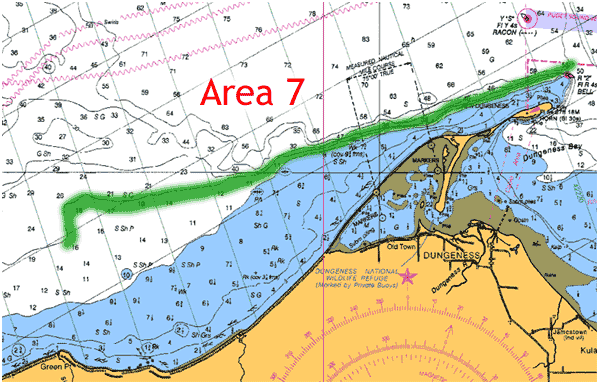
Area 7: Green Point located 5 1/2 miles east of Ediz Hook. If you troll for halibut, this is the place! Green Point is only a name location. It is a long series of sandy flats. Starting about half a mile west of Green Point, troll the 120 ft depth line on the flood tide. You can actually troll all the way to the Bell buoy at the tip of Dungeness Spit. This is a six-mile troll path. Reverse your direction of troll on the ebb tide. (east to west). Halibut can be caught anywhere along here in 70 to 260 ft. of water. Spend some time here and stay within 5 ft. of the bottom.
Location: N48°09′ x W123°17′.
Port Townsend (AKA Mid Channel Bank)
 Mid Channel Bank is located just off shore from Port Townsend. It runs from Marrowstone Point on the east, to Point Wilson on the west. Mid Channel Bank has become one of the most popular fishing areas in Puget Sound, as it offers year round Chinook action. Winter blackmouth are there from September to May, followed by summer Chinook starting to show up in June and peaking in July and early August.
Mid Channel Bank is located just off shore from Port Townsend. It runs from Marrowstone Point on the east, to Point Wilson on the west. Mid Channel Bank has become one of the most popular fishing areas in Puget Sound, as it offers year round Chinook action. Winter blackmouth are there from September to May, followed by summer Chinook starting to show up in June and peaking in July and early August.
Be sure to check with WDFW regulations as it opens and closes to salmon fishing at slightly different times every year.
All methods of salmon fishing can be productive at Mid Channel Bank. Moochers and jiggers usually fish the 60 to 100 ft depths. Downriggers are most productive in the 90 to 150 ft depths.
Because of the strong tidal flow along the edge of the bank, trollers are wasting their time trying to troll against the tide. Once you’ve reached the end of your troll, pick up your gear and run back to Marrowstone on an outgoing tide or Pt. Wilson on the incoming tide and start over again. During the brief period of slack tidal current, the salmon will scatter along the bank and can be trolled in either direction.
The most common bait in the winter and spring periods are sandlance (candlefish) especially when they move in to spawn. Keeping that in mind, use small spoons such as the Silver Horde “Coho Killer” and #3 Kingfisher. They work very well here. Also the Gold Star “Needlefish” and Ace Hi Fly’s match the dominant bait in the area.
When the summer Chinook fishing kicks off in early summer, larger bait (herring) will also start to move in and mix with the always-present candlefish. Larger lures such as the Gold Star “Hoochie Hooker” tend to do better on large Chinook. Silver Horde 4 and 5 inch Salmon plugs with glo and rattle, fished 40 feet behind the release clip, catch some of the largest Chinook of the year.
In the summer fishery, Chinook move past Mid Channel Bank on the incoming tide, and unlike the winter fishery, don’t linger in the area. The best tide to fish Mid Channel in the summer is the outgoing tide.
Moochers and Jiggers
Moochers and jiggers will do well by concentrating their efforts on either tide on the Marrowstone (east) side of Mid Channel Bank or off the Point Wilson Lighthouse. In both of these spots, year round the strong currents will push the bait into more shallow water.
Watch for diving birds up on the bank itself. There are holes and pockets that will hold diving birds up on the bank and they are most often over bait. These 40’ to 60’ pockets will also shelter feeding salmon and produce exciting fishing.
Shore Anglers
Anglers who are shore bound can do very well fishing the shoreline at Fort Worden State Park, casting Buzz Bombs and bait under floats. This fishery takes place mainly in the vicinity of the Lighthouse.
Boat Launches
Port of Port Townsend (Boat Haven) – 360-385-2355
Fort Worden State Park – 360-344-4400
Fort Flagler State Park – 360-385-1259
Fort Casey State Park (Whidbey Island) – 360-678-4519
Sekiu
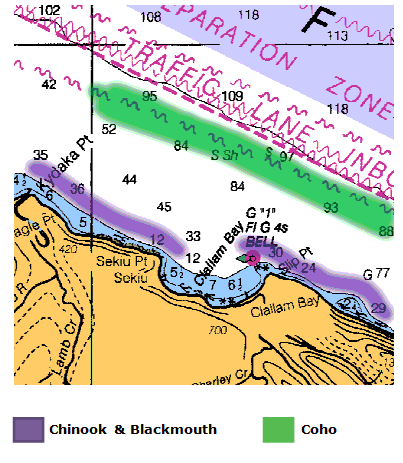
Large Blackmouth, Killer Summer Kings and Coho, too. That’s the big reason to be spending time fishing the Strait of Juan de Fuca.
Hands down for large blackmouth in February through the April closure you need to be on the Strait, lots of good water, plenty of bait can all lead to some fantastic blackmouth fishing. One of the most pleasurable things about this time of the year is lack of crowds. Many times I have fished Sekiu, to Port Angeles and had all the prime areas to fish with little or no angler pressure and plenty of hook ups.
Most winter fish run 5-10 pounds, but many winter blackmouth are taken into the upper teens each season near Sekiu making it worth the drive.
In Sekiu you can find some very productive angling in close to Clallam Bay.
You only need to go around the corner from the boat ramp and mooch out in front of the Caves to score on some nice fish. Winter salmon fishing is all weather dependent, there will be blackmouth out there, and the locals hammer them all winter. You just want to check the long-range weather before making the drive to save being blown off the water.
If the WDFW allows a summer season on the Straits for Chinook it’s a must fish time of the year, take off work sick, do whatever you need to do to be there, you won’t want to miss it.
Many large kings are taken during the July, the season is short but well worth the time. Motor mooching just off the kelp beds near the Caves have accounted for some kings in the mid 40-pound range.
Tactics: My personal favorite fishery here is to launch at Sekiu, run east to Pillar Pt. and troll back with the outgoing tide. The area from Pillar Pt. to Cod Fish Bay has over the years been one of my top producers. Troll the 120-130 ft depth line and keep your gear just off bottom. There has been very few times in the winter that a green spatter back glow squid 40″ behind a HotSpot flasher has not produced for me here. But if you haven’t scored yet there is plenty of prime water yet to fish. Move up and troll off the Coal Mine to Little Mussolini Rock. Here you want to fish the 130-150 ft. water.
Next stop on your Westerly troll is Big Mussolini Rock on Slip Pt. This is also a great mooching and jigging area.
Back across Clallam Bay, the Caves just out front of Sekiu are of course one of the most famous spots to fish here. Many a big king and blackmouth has been taken here. The caves all the way down to the Sekiu River can provide top-notch blackmouth fishing. Both trolling and mooching are very productive here. Work the 120-ft depth one-hour before two hours after the tide change. If I’m fishing summer kings I love to pull just a large herring off the downrigger just off bottom, this has accounted for some large fish.
Tackle: For trolling, don’t leave home without HotSpot flashers, hoochies in green and blue glow colors, standard and needlefish size, Silver Horde Coho Killer and Kingfisher Spoons in glow colors for downrigger trolling. Bring someSmelly Jelly to give the lures a good scent trail.
If you’re going to mooch or want to troll herring, bring it along, as it will be hard to find here during the winter season. During the summer fishery the resorts will normally order in what you need the night before.
Blackmouth: Love to feed near the bottom, trolling speed 2.0-2.5 Mph. Watch your sonar for bait concentrations and fish them hard. 120-130 ft depths will be the best producers along with fishing the tide changes. You can keep one blackmouth (chinook) day minimums size 22 inches to retain, the season stays open until 10 April. You can start seeing some early springers start to show in late March.
Kings: Best bet is July depending on if it opens check with the local resorts, the seasons are normal out by mid April and the town will book up quick. Motor mooching herring just off the kelp beds is the number one tactic, kick the boat in and out of gear in the 30-60 ft. water just after dawn. Later in the day I have had better luck trolling a flasher & herring combination in the 120-ft. water.
Coho: When the summer coho roll in, fishing can be stupendous. I have seen days where you can catch and release over a hundred coho in a day’s fishing. Most of the fishing takes place offshore 1-3 miles, however sometimes one need not go any further then the Sekiu buoy just outside the harbor. During July the coho run 5-10 pounds, later in September you will see the large hooknose fish show up, they can run in the upper teens. In 2001 many State records were broken with 20-pound plus fish. Trolling the tide rips is the hot tactic for these fish, most are taken in the top 30 feed of water. When they’re in, most anything will work, herring being the top choice, followed by spoons, then flasher squid combinations.
Bucktailing in the early morning is also very popular. Troll a bucktail fly on top of the water without any weigh fast enough to make it wake behind the boat. Coho love this and will jump clear of the water to take the fly. This makes for some great top water action. This tactic is great on overcast days or first thing in the morning before the sun comes up.
Sunsets West Grocery & Deli – a local food co-op selling fresh and locally produced food and goods. USDA certified grass fed beef is available to sustain the weary fisherman who doesn’t catch his day’s quota. Many wonderful aromatic spices for smoking the days catch. Comfortable seating with WiFi for patrons use. Chef’s choice daily super salads. Local roasted coffee and much more. Sunsets West Grocery is a member supported community store. You do not have to be a member to shop here. Everyone is welcome.
Sequim
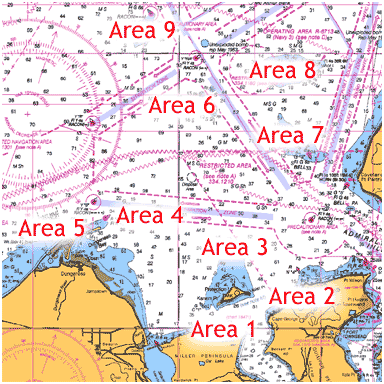 Sequim Bay is one of the most overlooked salmon and halibut locations in the Puget Sound area. There are two reasons for this: one being that locals are very quiet about the excellent fishing in this area. The second reason has to do with the peculiar fishing regulations the Department of Fish and Wildlife has burdened upon this area.
Sequim Bay is one of the most overlooked salmon and halibut locations in the Puget Sound area. There are two reasons for this: one being that locals are very quiet about the excellent fishing in this area. The second reason has to do with the peculiar fishing regulations the Department of Fish and Wildlife has burdened upon this area.
Sequim Bay is the jumping off point for excellent fishing for the inside Strait of Juan de Fuca. Coho fishing can be spectacular in September, winter blackmouth is a good fishery November through March, and halibut is a consistently good fishery in most years May through June.
Sequim Bay is protected water with one of the best marin
as in Puget Sound. John Wayne Marina (360-417-3440) offers moorage, fuel, a restaurant, public restrooms and showers.
There is a bait and tackle shop at the marina, The Bosuns Locker (360-683-6521). The Bosuns Locker has tackle, boat rentals, charters and the latest up to date fishing information for that area.
Across the street from John Wayne Marina is the Sequim Bay Resort (360-681-3853). They have RV parking available, a laundry facility, and 8 neatly kept housekeeping cabins that overlook the bay. There is an excellent state park nearby and the town of Sequim itself is just a few miles away.
Boat Ramps
1) John Wayne Marina – An excellent ramp with nice pitch and docks. Good on all tides and protected from the wind. There is ample parking and a washout station for cleaning your motors. A small fee is required for launching.
2) Sequim Bay State Park Ramp – This is a steep, shallow ramp. Four feet of water is needed to launch. Parking is often full.
Salmon and Halibut Fishing Areas
Area 1: Diamond Point A good year-round spot for blackmouth and, should seasons allow, summer Chinook. Sharp drop off, stay in the bottom 20 of water.
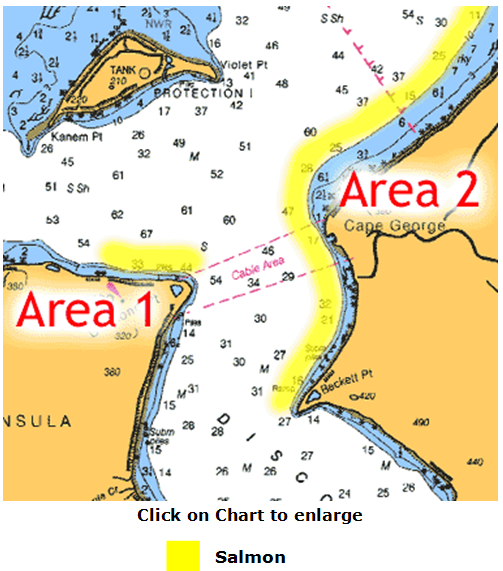
Area 2: Cape George – Good blackmouth area, fairly protected on the inside. Downriggers at 80 to 120 foot depths will do the trick. Hot Spot flashers with 48 of leader and a glow in the dark Coho Killer are good tackle to use in this area.
Area 3: Dallas Bank – Good for halibut along the edges. The bottom is mostly sand and gravel. Those who troll for halibut should fish the west side on the outgoing tide and move to the east side on the incoming tide. Troll slowly from 100 to 200 feet deep for halibut. Moochers do the best on the northern part of Dallas Bank. Moochers should start in 50 feet of water and drift out until you lose bottom. The rips that form off the northern tip of Dallas Bank are a good spot for fall coho.
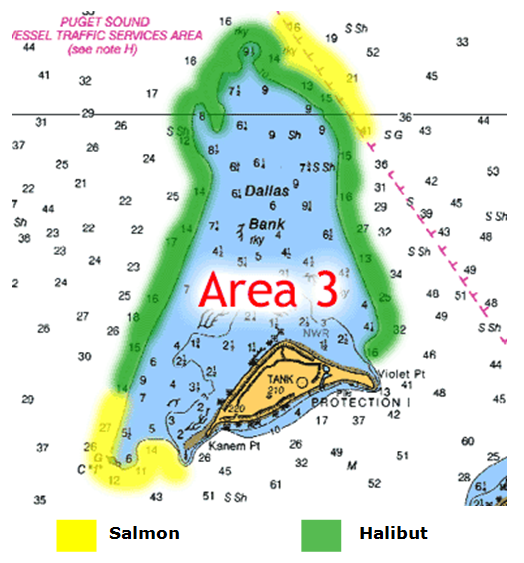
Area 4: Dungeness Bank – A good spot for halibut along the edges. This is a place where drift fishermen do very well. Start fishing in 100 feet of water and drift out to 240 feet of water.
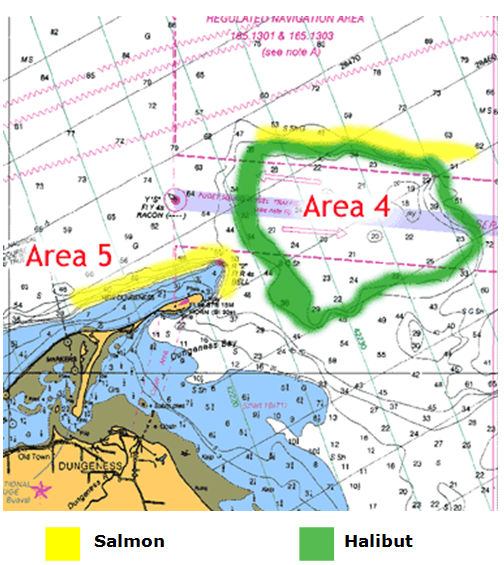
The northern edge of Dungeness Bank is a good year-round Chinook area. Be sure to check your regulations.
Area 5: Dungeness Spit – A good area for winter blackmouth. This area can be windy but you are only a few minutes from sheltered waters.
Area 6: Eastern Bank – Good area for lingcod and halibut. Eastern bank is a series of rocky pinnacles. Sometimes good for winter blackmouth. Fish the southwest side in 80 to 140 feet of water for both blackmouth and halibut.
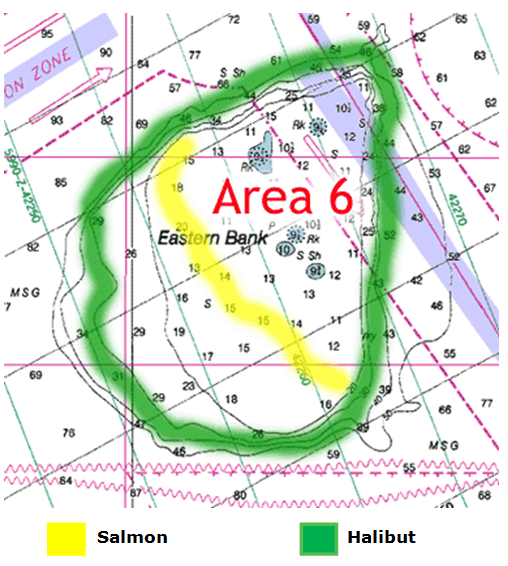
Area 7: Partridge Bank – Good for halibut on the southwest shelf. Fair for winter blackmouth on the incoming tide on the southeast corner. Fish the southwest side on the outgoing tide in 90 to 120 ft. of water.
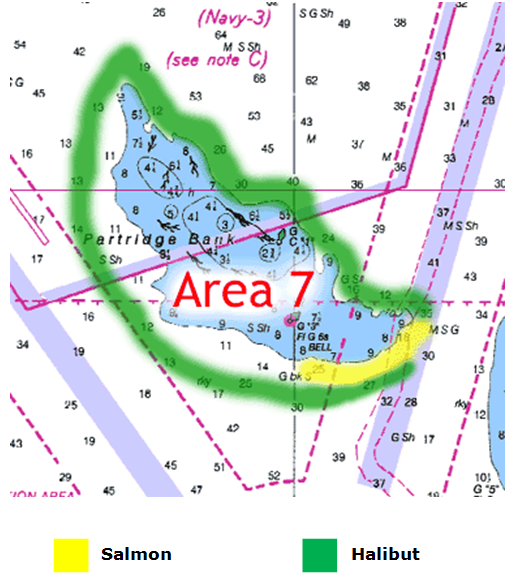
Area 8: Smith Island – Smith Island is just to the north of Partridge Bank. This is a good area for lingcod and fall coho fishing. A limited winter blackmouth fishery takes place on the outgoing tide on the west side of Smith Island. Coho can be caught on either tide by following the rips that form as the water flows over Smith Island. Very exposed to the weather and a long run to cover.
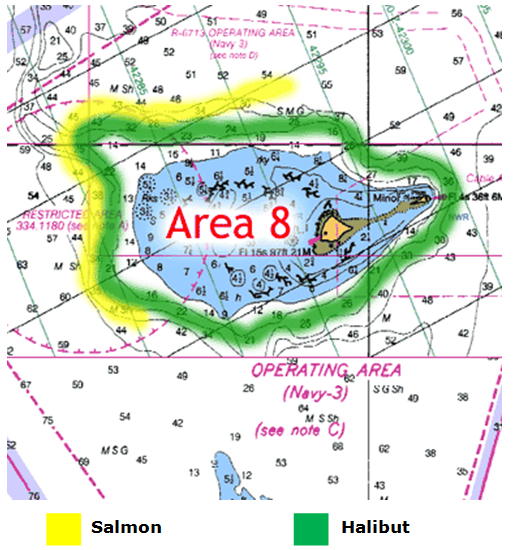
Area 9: Hein Bank – Hein Bank is a consistent producer of salmon and halibut. Moochers should concentrate their efforts along the northern edge of Hein Bank. Salmon trollers should troll the west side of the bank on the ebb tide and the east side of the bank on the flood tide. Halibut can be caught primarily on the southern edge of Hein Bank in 80 to 240 feet of water.
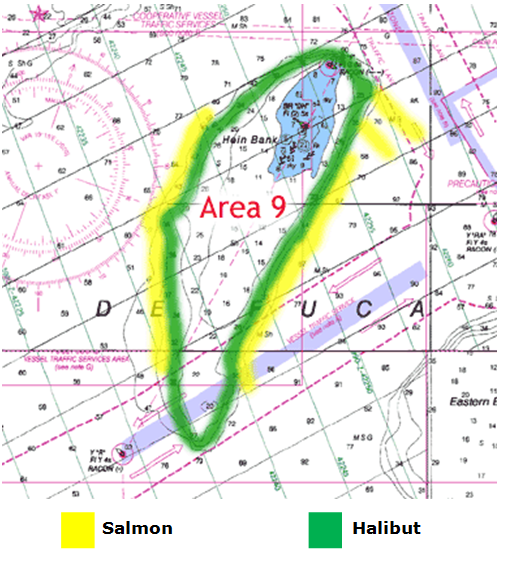
Sooke
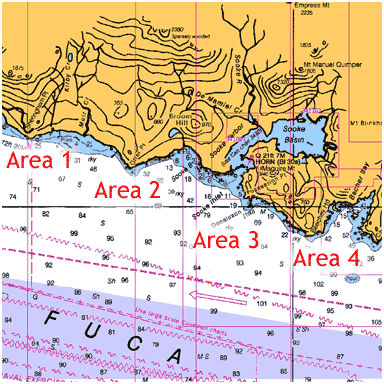 The Sooke area is the beginning of a salmon fishery that stretches from Sheringham Point on the west to Sidney, BC on the east. Located on the southern tip of Vancouver Island, Sooke offers world class salmon angling that can rival any place on the West Coast.
The Sooke area is the beginning of a salmon fishery that stretches from Sheringham Point on the west to Sidney, BC on the east. Located on the southern tip of Vancouver Island, Sooke offers world class salmon angling that can rival any place on the West Coast.
Sooke offers almost a twelve-month fishing opportunity, with the slowest months being October and November. Even then, chum and early blackmouth offer opportunity.
The fishing calendar year for Sooke begins in December with the arrival of winter blackmouth. These immature Chinook are attracted to this area by the schools of herring and candlefish that move in to spawn. The sports anglers in the Sooke area often catch their limit within an hour at this time of year. This fishery is usually good into May.
Mature Chinook – In early May, the first of what the BC anglers refer to as Columbians begin to show. These are thick-bodied Chinook in the 30 to 50 pound range. Columbians were formerly thought to be Chinook from the Columbia River just dipping in to feed. However, tagging studies revealed that they are early Fraser River returns. These fish continue to pass by in good numbers until the middle of July.
As the “Columbians” run begins to disappear, the fall Chinook begin to arrive and the fishing continues without skipping a beat. The last of the Chinook runs usually have passed by the end of August.
Coho – The coho are abundant in July, August and September. Due to British Columbias programs to restore coho runs, check the regulations, as they will change with season updates. The coho in the Sooke area in July and August are for the most part 5 to 9 pounds. In September the big, fat, hard fighting fall coho in the 10 to 20 pound range show up. These runs of coho can continue into early October.
Humpies – The Humpies run on the odd year. Since these are a mixture of Fraser River and Washington stock, the number of salmon can be tremendous. Humpies arrive in August and limits (4 each day) are easily achieved by even the beginning angler.
Halibut – Halibut are available in the Sooke area at all times of the year. The only month halibut fishing is closed in this area is January. The peak halibut fishing is February until June and then slows. The halibut usually are in the 10 to 30 pound range, but several are caught every year in the 70 to 150 pound sizes.
Fishing Areas
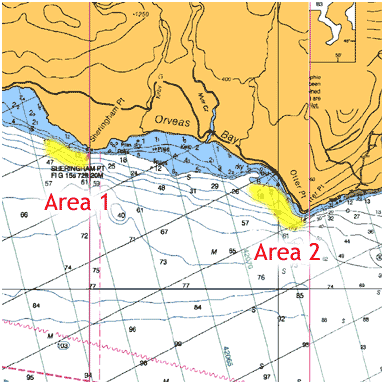 Area 1 – Sheringham Point – A short westerly run from Sooke Basin brings you to Sheringham Point. The lighthouse at the point easily identifies this area. Fish the west side of Sheringham on the outgoing tide. Winter blackmouth are usually deep, in the 90 to 150-foot depths.
Area 1 – Sheringham Point – A short westerly run from Sooke Basin brings you to Sheringham Point. The lighthouse at the point easily identifies this area. Fish the west side of Sheringham on the outgoing tide. Winter blackmouth are usually deep, in the 90 to 150-foot depths.
The Columbians and fall Chinook are usually caught quite close to shore, sometimes in 20 to 30 feet of water.
Coho are in the rips further off shore. A back eddy forms on the outgoing tide at Sheringham. Get in line with the other boats in the area and work this area. Dont troll against or across the paths of the other anglers. The first hour on the incoming tide is good to the east side of Sheringham Pt. Fish the 100 to 120 foot depths.
Anglers casting from shore with Buzz Bombs and jigs often take Chinook off this point.
Area 2 – Otter Point – The first point to the west of Sooke Inlet is Otter Point. Spring and early summer Chinook fishing can be quite productive here and as a result often quite crowded. Otter Point is best fished on the outgoing tide.
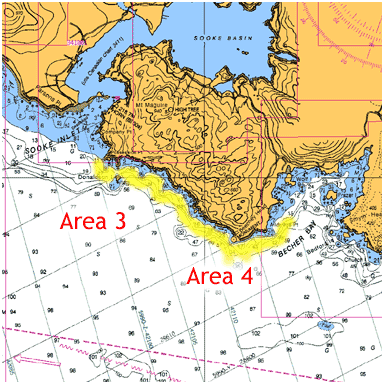 Area 3 – Possession Point – This is the start of a long troll with a lot of water and possibilities of fish anywhere along the beach. Possession Point is just to the east of Sooke Inlet. Often Chinook lay at the edge of the kelp beds. Troll from Possession to Donaldson Island (usually called Secretary Island by locals). Stay close to the kelp beds and fish all the west side of Secretary Island on the outgoing tide. On the incoming tide move to the east side of Secretary Island.
Area 3 – Possession Point – This is the start of a long troll with a lot of water and possibilities of fish anywhere along the beach. Possession Point is just to the east of Sooke Inlet. Often Chinook lay at the edge of the kelp beds. Troll from Possession to Donaldson Island (usually called Secretary Island by locals). Stay close to the kelp beds and fish all the west side of Secretary Island on the outgoing tide. On the incoming tide move to the east side of Secretary Island.
Area 4 – This area is best trolled from Secretary Island down to Beechy Head. Moochers can work the edges of Secretary Island and do quite well. Beyond there, however, is trolling water.
This area should be trolled for winter blackmouth in the 90 to 150 foot depths, staying within the bottom 20 feet of water. Summer Chinook will lay quite close to shore.
Coho will be along the rips anywhere from close to shore out into the middle of the Straits of Juan de Fuca.
On the odd numbered years, humpies will be everywhere.
As you move towards the west side of Beechy Head, the bottom comes up abruptly and many a downrigger ball, including some of my own have been left here.
The east side of Beechy Head is a good place to fish on either tide and often has an excellent evening bite.
Boat Launches
Sooke Harbour Marina (250) 642-3236
Sunny Shores Marina (250) 642-5731 Gas is available here for boats.
Warning: Sooke Harbour is very shallow in the middle of the bay. Stay close to shore and follow the channel markers.


